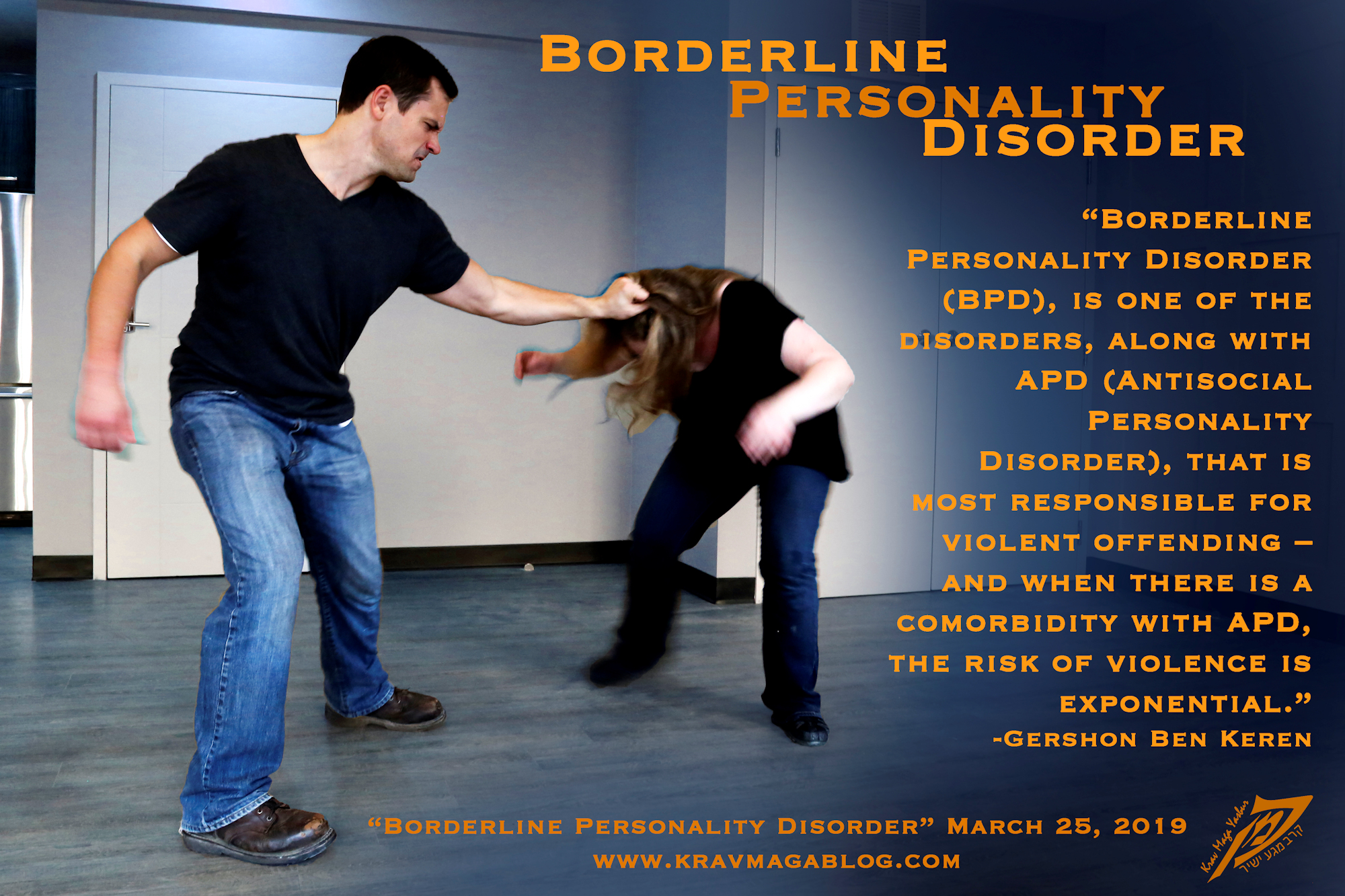Borderline Personality Disorder, is an article written by Gershon Ben Keren, a 5th Degree Black Belt in Krav Maga, who teaches Krav Maga in Boston, MA. He has also authored three Amazon best-Selling Books on Krav Maga.
Last week’s article looked at antisocial personality disorder (APD) and violence. This week’s article is about another personality that is associated with violence: borderline personality disorder (BPD). In the UK, when the two are comorbid/present together it is likely that a medical-legal diagnosis of dangerous and severe personality disorder (DSPD), will be made e.g. 78% of criminals undergoing treatment for DSPD in the UK, have APD+BPD, making it the most common type/form of DSPD. Whilst both those with APD, and BPD, have a tendency to become aggressive and violent, their motivations for doing so, and the way they use violence, are somewhat different. Those with APD, tend to use violence in an instrumental fashion, to achieve a particular goal, such as attacking someone in a parking lot to steal their car. Those with BPD tend to use violence proactively, to control somebody in order to meet a personal need e.g. threatening a partner with violence so as to avoid them ending the relationship; or reactively, expressing anger at the way somebody is behaving or acting towards them – there has long been an association with intimate partner violence (IPV) and BPD; which is partly due to the fear of abandonment that is a characteristic of this disorder. If an individual has a proneness to use violence instrumentally, proactively and reactively (in almost every situation), it can be seen why those with APD+BPD, account for such a large percentage of violent crime.
One of the differences between BPD and APD, concerns an individual’s stability around their self-identity. Those with APD, largely “know who they are”, and have a generally stable sense of self. This is not the case with those who have BPD, where they are constantly questioning who they are and reinventing themselves when their self-image starts to break down and fall apart e.g. they may ask to be called by a different name, dress differently, decide to embark on a different career, etc. In diagnoses this changeability sometimes get confused with the manic episodes that those with Bipolar go through; they are down, depressed for a period of time, and then upbeat and euphoric, for a period of time, etc. However, the big difference is that for somebody with BPD, these shifts and changes may occur on a daily or even in serious cases, hourly basis. This is in contrast with those who suffer from Bipolar, where episodes of mania last for much longer periods of time. This instability, and inability to manage identity can also cause psychic-breakdowns which manifests itself as “Narcissistic Rage”. If a person with BPD is going through a period where they have an extremely positive view of themselves, and then something happens to cause them to question that, then they will feel a need to defend their view of themselves, and the way they do this is to go on the attack, certainly emotionally and aggressively, and sometimes violently – their use of violence can be both proactive and reactive at the same time. Imagine someone who has created the view of themselves as being at the top of their game, and subsequently they have tied their whole identity to this viewpoint, and then they see somebody else who they believe is doing better than them. This doesn’t and can’t marry up, and to avoid the psychic-breakdown, that they were perhaps wrong about themselves, they go on the attack, lashing out at anybody and anything in a hope to reinforce their idea of who they are.
One of the big and constant fears of those with PPD is abandonment, and this is a marked feature of this disorder which separates and differentiates it from APD. Obviously, those involved in intimate partner violence (IPV) or “battering” are a heterogeneous group, however personality disorder, is a dimension that is always worth investigating. As I have written about before, physical abuse is only one type of relationship abuse; there is also psychological, emotional, sexual and financial, and this type of abuse does not always involve physical contact e.g. if one partner prevents another from leaving a room by standing in the doorway, it is physical abuse - and the same is true if they snatch things out of the other’s hand, or throw something close to them, etc. In terms of physical abuse where physical contact is made, BPD, is often a commonality throughout cases. In any risk-assessment of violence, it is important not to become overly focused on the clinical disorder, but to consider dispositional, contextual and historical factors e.g. someone with BPD who has a predisposition to anger, and a history of becoming angry and violent is more likely to engage in aggressive and violent acts, than somebody with BPD who lacks these things, etc. Unfortunately, we often have a desire to find a single, attributable reason for somebody’s aggressive/violent behaviors and actions than recognize that it is the result of several different components interacting together in a certain way. There may be certain things which trigger a violent reaction in one individual with BPD, that don’t affect another, so we should always be careful, to avoid making a clinical disorder such as BPD, solely attributable for violent offending.
When looking at the neurobiology of BPD, it is interesting that it shares many similarities with post-traumatic stress disorder (PTSD). In both groups of sufferers, there are similar volume reductions in both the Hippocampus and Amygdala areas of the brain, compared with non-sufferers/control groups, and when accounting for those with both BPD and PTSD, smaller volume sizes were more attributable to borderline personality disorder that PTSD, suggesting that it is something other than trauma, is responsible for BPD i.e. it is due to something internal, rather than external, etc. It is also interesting to note that such volume size reductions only occurred in adults with BPD, suggesting that this is the result of the disorder, not the cause. The main function of the Amygdala is in fear detection, and the Hippocampus is involved in emotional regulation, so any reduction in volume, and functioning is likely to make somebody more susceptible to misidentify threats and danger.
Borderline Personality Disorder (BPD), is one of the disorders, along with APD (Antisocial Personality Disorder), that is most responsible for violent offending – and when there is a comorbidity with APD, the risk of violence is exponential. When making any risk-assessment of violence, the clinical condition is only one part, and dispositional factors, such as irritability, anger, and mood swings (which may also be part of a disorder), need to be considered as well. Whilst APD often gets the most attention as the disorder associated with violent offending, BPD needs to be seriously considered as well.
0 COMMENTS















